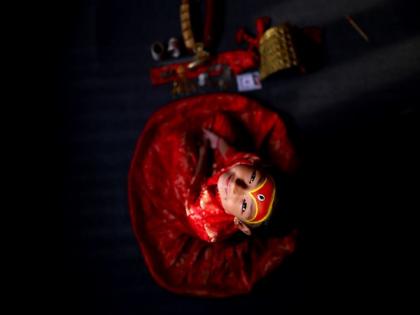Search for Nepal's new 'Living Goddess-Kumari' begins
By ANI | Published: April 14, 2022 01:59 PM2022-04-14T13:59:37+5:302022-04-14T14:10:02+5:30
Panauti, an ancient town in Nepal, is all set to begin the search for a Living Goddess-Kumari.

Search for Nepal's new 'Living Goddess-Kumari' begins
Panauti, an ancient town in Nepal, is all set to begin the search for a Living Goddess-Kumari.
"Kumaris are usually replaced before their menstruation but we are opting to retire her at the age of nine years. In Newari culture we have to perform the rituals of Ihi: (marrying the wood apple) and Gufa (a solitary confinement ritual) which needs to be done before the period. We are consulting about it with the local communities here," Rohini, the mother of Living Goddess said.
As per her, Panauti possibly would get a new Living Goddess next Dashain, that of 2079 BS. In Kathmandu, a young Newar girl with no blemishes is chosen to represent the Goddess Kumari as an incarnation of Goddess Taleju, the tutelary deity of the Malla dynasty, and the Shah dynasty which inherited the tradition.
Ojaswi Ghulu, appointed living Goddess-Kumari of Panauti, an ancient town in Nepal, after a gap of eight decades, lives a normal life like other kids except when there are major festivals during which she is worshipped.
She plays, studies, and watches television while also pursuing other interests. The Living Goddess is fond of painting and cycling.
Ojaswi Ghulu was only eight months old when she was anointed "Living Goddess". It was a moment of pride for the ancient city in the Kavrepalanchowk district as it revived the almost extinct cultural practice.
"Hyumat's (sacred persons) were here and they came to this town saying that a Kumari should be appointed at those places where the temple of Talaeju Bhawani lies. As they searched around, they found that Panauti also hosts the Taleju Bhawani temple. Actually, a Kumari should have come from Suwal families. But there was no girl child among them, so a Kumari was chosen from the Ghulu family which has similar traits," Rohini Ghulu, the mother of Living Goddess of Panauti, told ANI.
Anointment of Kumari in the Panauti doesn't follow the procedure of Kathmandu for similar ritual. The Hyumat's a group of sacred and religious people who search for girls who haven't trimmed their hair, matching parameters to zero in on the next "Living Goddess".
She appears in public in regalia only twice a year. She is worshipped for 10 days during the fortnight festival of "Dashain" and on Ram Navami.
Nowadays, her daily routine starts with drinking a glass of cow's milk and eating biscuits. She is not allowed to share her plate with anyone else and the sacredness of food is maintained.
In order to maintain the sanctity, the Living Goddess only takes part in functions that are held inside the home or the family. Black coloured robes are kept off the perimeter of the Living Goddess and her hair is not trimmed.
In Nepal's traditions, a Living Goddess is seen as a form of Hindu Goddess being the symbol of religious tolerance while a number of people here in the Himalayan nation come from the Buddhist background. For centuries, the goddesses were used by kings to legitimize their rules.
Preparing the Kumari
Kumari of Panauti follows the daily routine like a child of her age on normal days. During the festivities, it becomes busier for her. She has to get up early in the morning, freshen up and put on the regalia and get herself decorated.
The artist who is Living Goddess' cousin brother paints her forehead with red and yellow edging and fixes the ceremonial third eye on her forehead. The ceremonial third eye is made of either gold or silver. Her hair is coiled with topknot with red cords, lipstick, nail polish and various ornaments which includes the Bajra and royal crown.
"While preparing her I always try to find out her mood. I always show my respect and devotion to her at the time decorating her, like others I cannot direct her to do things always speak on soft tone," Prabin Shrestha, cousin brother and artist of the Living Goddess of Panauti, told ANI.
As per the artists it takes about one or two hours to prepare her after which she is ascended to her sacred throne set on the top of the house where she is worshipped by other family members.
After getting ready, the living goddess is taken to Layaku Durbar, a 15-minute walk from her house, on the shoulders of her father, not letting her touch the ground. It is made sure that the living goddess doesn't touch the ground barefoot when she has make-up on.
( With inputs from ANI )
Disclaimer: This post has been auto-published from an agency feed without any modifications to the text and has not been reviewed by an editor
Open in app